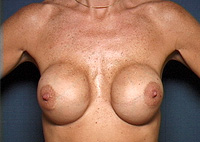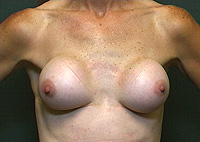Capsular Contractures
In virtually every woman who has breast augmentation, the body responds to the presence of the implants by forming a capsule of scar tissue around the implant. Like scars on the skin surface, the development of scar tissue is a process that starts within days of surgery and continues for a year or more. Most often, the presence of this scar capsule is not detectable, and the breasts look and feel very natural. Sometimes, however, the capsule contracts around the implant. The breast will then feel firm to hard, and in some cases, the shape of the breast will be distorted.
What does Capsular Contracture look like?

 Example photos of Capsular Contractures
Example photos of Capsular Contractures
What causes Capsular Contracture?
No one knows exactly why the capsules surrounding the breast implants contract, nor can they predict who will develop this problem.
One hypothesis is that they occur because of an infectious stimulus. In spite of sterile techniques, bacteria are still present on the skin surface, in the air and within the ducts of the breast tissue. Every plastic surgeon has their own personal surgical ritual they believe lowers the chances of capsular contractures. Some are quite elaborate, and others very simple.
Most surgeons believe that adhering to these common-sense procedures will reduce the incidence of capsular contracture:
- Avoiding incisions that go through the breast tissue (as they do in the peri-areolar incision technique)
- Irrigating the implant and the pocket created to hold it with antibacterial agents
- Giving the patient oral antibiotics around the time of surgery
- Touching the implant as minimally as possible
- Using talc-free gloves during surgery
Although some studies indicate that the rate of early capsular contractures is less when these techniques are used, there are to date no long-term studies to show they actually result in fewer capsular contractures overall. Other factors—such as implant placement above or below the pectoralis muscle, saline or silicone filler, surface of the implant, and post-operative massage—seem to affect the rate of capsular contracture. Capsular contractures are not life threatening, but they certainly don’t look or feel “natural.” They can also be painful and distorting.
If they develop, capsular contractures are best dealt with surgically by excising some or all of the capsule and starting over. The chances of developing capsular contractures again, however, is higher once you have demonstrated the propensity to develop them once. Finding the cause of capsular contractures and preventing their development has become the Holy Grail of breast augmentation surgery.
Read more of Dr. Saltz’s articles about breast augmentation:
- Introduction: Talking About Breast Augmentation with Dr. Lori Saltz
- The History of Breast Implants
- The Evolution of Silicone Breast Implants
- Types of Saline Breast Implants
- Anatomical Factors To Consider With Your Surgeon
- All About Incisions: Choosing Your Incision Placement
- Implant Placement: Over or Under the Muscle?
- What Can Go Wrong With Breast Augmentation?
- What Is Capsular Contracture?
- Scheduling a Breast Augmentation Consultation at LJC

